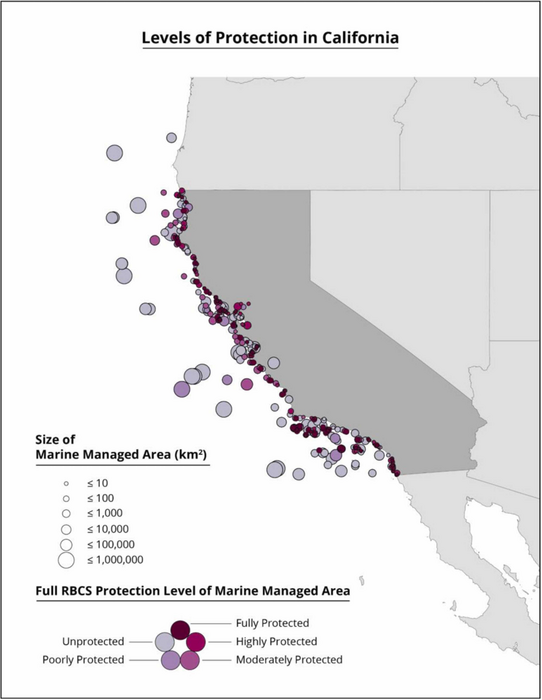A new study offers a science-based method to assess marine protected areas (MPAs) protection levels when information on regulated human activities is limited. The study, recently published in the journal Marine Policy, provides a new technique to inform progress towards international conservation goals, including protecting 30 percent of marine areas by 2030, which was adopted in Dec. 2022 at the UN Biodiversity Conference in Montreal, Canada, known as COP15.

Credit: ProtectedSeas
A new study offers a science-based method to assess marine protected areas (MPAs) protection levels when information on regulated human activities is limited. The study, recently published in the journal Marine Policy, provides a new technique to inform progress towards international conservation goals, including protecting 30 percent of marine areas by 2030, which was adopted in Dec. 2022 at the UN Biodiversity Conference in Montreal, Canada, known as COP15.
Marine protected areas are an important tool to conserve marine biodiversity but oftentimes assessing the level of protection for MPAs can be difficult due to limited regulatory information on human activity.
The analysis, based on real-world scenarios using MPAs and other managed areas in California, showed that the ProtectedSeas Navigator’s Level of Fishing Protection (LFP) score can help guide assumptions about whether specific fishing methods required for assessments are likely allowed or prohibited when those methods are not mentioned in management plans.
The LFP guidance reliably identified areas that scored highly or fully protected under a full analysis when combined with assuming unknown non-fishing activities such as aquaculture and bottom exploitation, to be ‘prohibited’ while unknown activities such as boating, anchoring, and fishing activities to be ‘allowed.’
“This case study illustrates how Navigator is a valuable resource to estimate progress towards 30×30. These findings show that Navigator can accelerate MPA review and help guide assessment decisions even when information is incomplete,” said ProtectedSeas Director Virgil Zetterlind, a coauthor of the study.
In the first set of scenarios in this analysis, information available in direct management plans was applied to the Regulations Based Classification System (RBCS). Ninety-nine and 100 percent correct classification of fully and highly protected areas under the RBCS, were obtained when unknown activities such as aquaculture, bottom exploitation, and bottom extraction were assumed ‘prohibited’ while unknown and boating, anchoring, and fishing activities were assumed as ‘allowed.’
In the second set of scenarios, the researchers used only information available in the ProtectedSeas Navigator that matched those in the RBCS with no additional research. They found that the accuracy remained high, with 92 and 94 percent of fully and highly protected areas classified correctly when using assumptions for fishing activities assisted by the Navigator’s Level of Fishing Protection score.
The RBCS predicts MPA effectiveness based on the types of human activities allowed and their relative impacts on the marine environment. While comprehensive, these assessments are resource intensive as they require significant knowledge about a wide range of fishing methods and human activities that are often managed by different authorities.
ProtectedSeas Navigator captures more than 50 individual attributes of protected areas including the allowed or prohibited status of eight different fishing gear and 10 other human activities. Navigator’s LFP scoring system uses an easy-to-follow decision tree that does not require a complete set of fishing and activity restrictions to assess a 1 to 5 score.
ProtectedSeas’ Navigator is the most comprehensive database of marine life protections and their boundaries available. Navigator provides a free, interactive map of regulatory information for MPAs and marine managed areas (MMAs) in over 22,000 marine areas for coastal and island countries and the high seas and the complete set of Navigator data is available in many formats and channels to support assessment, planning, and analysis.
“Using standardized, scientifically validated methods to assess global progress towards the UN 30×30 target is critical to ensuring effective conservation and not just creating more paper parks” said Zetterlind. Navigator can help the marine conservation community understand where they need to go to create protections.”
# # #
ProtectedSeas is the curator of a growing and open dataset of boundaries and regulations for marine protected areas (MPAs) and marine managed areas (MMAs) globally. Learn more at: https://protectedseas.net. Follow us on Facebook @ProtectedSeas.
Journal
Marine Policy
DOI
10.1016/j.marpol.2022.105441
Method of Research
Case study
Subject of Research
Not applicable
Article Title
Guidance on marine protected area protection level assignments when faced with unknown regulatory information
Article Publication Date
1-Feb-2023




